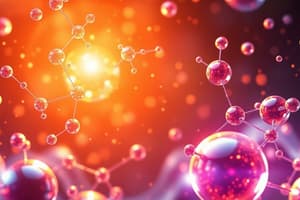Podcast
Questions and Answers
What is the typical characteristic of ionic bonds?
What is the typical characteristic of ionic bonds?
- Formed through the sharing of electrons between atoms
- Results in the formation of a polar molecule
- A type of intermolecular force
- Formed through the transfer of electrons between atoms (correct)
What is the electronegativity difference range for polar covalent bonds?
What is the electronegativity difference range for polar covalent bonds?
- Between 0.5 and 1.7 (correct)
- Less than 0.5
- Greater than 1.7
- Between 1.7 and 2.5
Which theory predicts the shape of molecules based on the arrangement of electron pairs?
Which theory predicts the shape of molecules based on the arrangement of electron pairs?
- Valence Shell Electron Pair Repulsion (VSEPR) Theory (correct)
- Valence Bond (VB) Theory
- Hydrogen Bonding Theory
- Molecular Orbital (MO) Theory
What is the energy required to break a bond?
What is the energy required to break a bond?
Which type of bond is formed between a hydrogen atom bonded to a highly electronegative atom and another electronegative atom?
Which type of bond is formed between a hydrogen atom bonded to a highly electronegative atom and another electronegative atom?
What is the ability of an atom to attract electrons in a bond?
What is the ability of an atom to attract electrons in a bond?
Flashcards are hidden until you start studying
Study Notes
Types of Chemical Bonds
- Ionic Bonds:
- Formed through the transfer of electrons between atoms
- Typically between a metal and a nonmetal
- Results in the formation of ions with opposite charges
- Electronegativity difference > 1.7
- Covalent Bonds:
- Formed through the sharing of electrons between atoms
- Typically between two nonmetals
- Results in the formation of a molecule
- Electronegativity difference < 1.7
- Polar Covalent Bonds:
- A type of covalent bond with a partial positive and partial negative charge
- Formed when there is a moderate electronegativity difference (0.5-1.7)
- Results in a polar molecule
- Hydrogen Bonds:
- A type of intermolecular force
- Formed between a hydrogen atom bonded to a highly electronegative atom (F, O, N) and another electronegative atom
- Important in biological systems (e.g., DNA, proteins)
Bonding Theories
- Valence Shell Electron Pair Repulsion (VSEPR) Theory:
- Predicts the shape of molecules based on the arrangement of electron pairs
- Electron pairs arrange themselves to minimize repulsion
- Molecular Orbital (MO) Theory:
- Describes the distribution of electrons in molecules
- Combines atomic orbitals to form molecular orbitals
- Valence Bond (VB) Theory:
- Describes the formation of bonds through the overlap of atomic orbitals
- Focuses on the pairing of electrons in bonds
Bonding Characteristics
- Bond Length:
- The distance between the nuclei of two bonded atoms
- Influenced by the size of the atoms and the type of bond
- Bond Energy:
- The energy required to break a bond
- Influenced by the type of bond and the atoms involved
- Electronegativity:
- The ability of an atom to attract electrons in a bond
- Increases from left to right and bottom to top of the periodic table
Types of Chemical Bonds
- Ionic bonds form through electron transfer between atoms, typically between a metal and a nonmetal, resulting in ions with opposite charges, and occur when the electronegativity difference is > 1.7.
- Covalent bonds form through electron sharing between atoms, typically between two nonmetals, resulting in a molecule, and occur when the electronegativity difference is < 1.7.
- Polar covalent bonds are a type of covalent bond with partial positive and partial negative charges, forming when the electronegativity difference is between 0.5-1.7, resulting in a polar molecule.
- Hydrogen bonds are a type of intermolecular force forming between a hydrogen atom bonded to a highly electronegative atom (F, O, N) and another electronegative atom, and are important in biological systems (e.g., DNA, proteins).
Bonding Theories
- Valence Shell Electron Pair Repulsion (VSEPR) Theory predicts molecular shape based on electron pair arrangement, with electron pairs arranging themselves to minimize repulsion.
- Molecular Orbital (MO) Theory describes electron distribution in molecules, combining atomic orbitals to form molecular orbitals.
- Valence Bond (VB) Theory describes bond formation through atomic orbital overlap, focusing on electron pairing in bonds.
Bonding Characteristics
- Bond length is the distance between the nuclei of two bonded atoms, influenced by atom size and bond type.
- Bond energy is the energy required to break a bond, influenced by bond type and atoms involved.
- Electronegativity is an atom's ability to attract electrons in a bond, increasing from left to right and bottom to top of the periodic table.
Studying That Suits You
Use AI to generate personalized quizzes and flashcards to suit your learning preferences.




